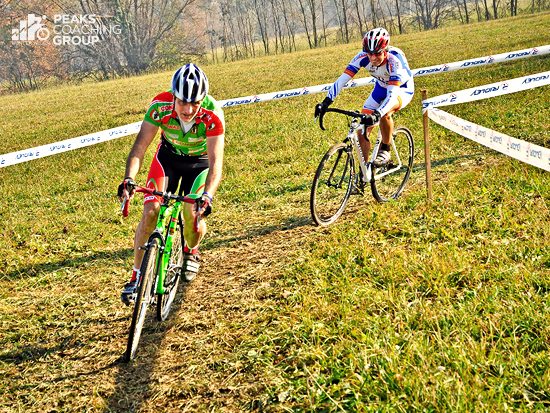by Tim Cusick, PCG Elite/Master Coach
Cyclocross has to be one of the hardest forms of bicycling racing out there, and because of its short but uber intense race style, it requires some specialized training to ensure success. Over the years I’ve identified a few myths riders often believe about both training and performance. Thankfully they are easy to correct! Click through to find out how…
Myth 1: CX is all about anaerobic capacity.
One of the most confusing aspects of cyclocross training is that the nature of the event convinces us that anaerobic capacity (the number of “matches” we can burn) becomes the limiter to performance. This often leads riders to plan a ton of high-intensity workouts into their weekly schedule in an effort to expand their ability to burn matches. However, while this type of intensity is a major factor, it typically is not the key limiter. If you’re training and racing with power, take a look at the last race you “cracked” in and start reviewing backward. I’ll bet that at first you’ll see that yes, the time period before burned some heavy matches and effort, with too short of a recovery. And it would appear that a lack of anaerobic capacity is to blame, right? But take a closer look at the normalized power of the effort (note: normalized power isn’t always fully accurate under 20 minutes, but it’s a good guide). You will likely notice two things. First, the average of the efforts will be at about 105-110% of your FTP, and second, it will be in the time range of about 12-18 minutes before you cracked. Don’t get me wrong, the match burning hurt, but the limiter was more than likely your FTP.
In cyclocross we need to keep a focus on FTP and not neglect our ability to maintain sustained power. Of course we need short, hard training efforts for success, but at the end of the day we need to keep FTP high if we’re going to hang with the pack during an extended period of hard attacks and counters. This means putting two or three FTP-building workouts a week into our cyclocross base and maintaining at least one per week during the race season.
FTP Workouts
On your local course, park, or fields, add these two workouts to your strategy of increasing and maintaining your FTP.
WORKOUT 1: SST Over/Under
WU: 15-20 minutes working at endurance (Level 2 watts, endurance heart rate) with 2 x 1-minute fast pedals to wake up your legs
MS1: Complete 2 x 20-minute intervals at 89-92% of FTP (Level 3/4 watts, high tempo heart rate), then every 2 minutes pop it up to 120% of FTP (Level 6 watts, anaerobic capacity heart rate) for 30 seconds (this 30 seconds can also be a dismount and hard run), then recover back to 89-92%, but nothing below 85%! Rest 5 minutes between sets.
CD: 15 Minutes
WORKOUT 2: Micro Intervals
WU: Warm up for 15 minutes, building to endurance zone. Complete 3 x 1-minute fast pedals as part of warm-up.
MS: Microbursts help build leg strength and FTP! Using your local cyclocross training course, complete 3 x 10-minute microburst intervals with 5 minutes rest between sets, with one burst being 15 seconds ON (150% of threshold power) and 15 seconds OFF (50% of threshold power). Repeat continually for 10 minutes.
CD: 10 Minutes easy pedaling
Myth 2: I really don’t need to run much to be good at CX.
This is actually partially correct, but what people often underestimate is the effect of transition running. Part of why cyclocross is so drool-on-your-handlebars hard is the transition of ride, get off, run, get on, and ride again. These transitions engage different muscles and efforts, often increasing the demand on the cardiovascular system in response. To endure cyclocross we have to practice transitional running and prepare our bodies for the associated increased demand. You won’t need a ton of running, just some built into your workouts to prepare your body for the demand.
I build running into a lot of workouts for my athletes. In the base building block I typically add two to three days of running to the mix.
Running Workouts
On your local course, park, or fields, add these two workouts to your strategy to build running into both your high-intensity workouts and FTP-building efforts.
WORKOUT 1: 30-30-30-30
WU: 15 minute warm-up in endurance zone with a solid 5-minute tempo+ effort to open up the legs
MS1: Cyclocross hurts, and so do the workouts that matter! On your local course (or create a course at your local school or park) complete 2 x 12 minutes of 30-30-30-30. This means 30 seconds riding as hard as you can, 30 seconds coasting and not pedaling, 30 seconds dismounted and running fast, 30 seconds coasting and not pedaling. Continue this process for 12 minutes to complete the interval, then ride 10 minutes easy and go to MS2.
MS2: Complete 4 x 2 minutes all out (anaerobic capacity work). Push hard and fast. Rest 2 minutes after each.
CD: 15 minutes
WORKOUT 2: Wind Up and Run
WU: Warm up for 10-15 minutes, ranging from zone 1 to zone 2. Add 2 or 3 1-minute fast pedals to wake up your legs.
MS: Let’s build some leg strength! On your cyclocross bike, ride to a flat or slightly uphill open field and complete 12 53:13 start wind-ups and runs. To do this, simply mark a starting point, drop into your bigger gear riding about 2 mph, hit the line, and attempt to get to 90 rpm as quickly as possible. Really use your arms and core to help you get on top of the gear. As soon as you hit 90 rpm, dismount and sprint hard for 20 seconds, then remount and coast it out to complete the interval.
CD: 10 minutes easy riding
Myth 3: I should focus on fitness and ignore efficiency.
A great cyclocross racer is not only fit but also smooth and efficient. Skilled bike handling, smooth transitions, and efficient barrier management all translate directly to faster race performance, but riders typically spend less than 10% of their training time building these skills. Cyclocross is a skill cycling sport, and we need to dedicate more time to improving our skills and efficiency as part of the quest for better performance. Find time for skills in your cyclocross training. It will pay off in the long run.
Skill-Building Workouts
On your local course, park, or fields, add these two workouts to build your skills.
WORKOUT 1: Endurance Drills and Skills
WU: 15 minutes warming up into endurance zone (Level 2 watts). Include 2 x 1-minute fast pedals and a 2-minute effort at FTP to open up.
MS: Ride one hour of endurance to your local course for the following drills:
DRILLS:
2 x 10 barrier runs. Set up 2 barriers about 10 meters apart and practice your dismount, carrier, barrier hop, and remount. Focus on smoothness. Do these in a back-and-forth pattern; out and back counts as one. Do these at race speed.
1 x 10 bike carry hill. Find a small hill about 10 meters long and practice riding hard to the hill (30-second sprint), dismounting, shouldering your bike, and sprinting to the top. Remount and practice riding back down fast.
1 x 5 grasser. Find a soccer field or a large open field about 40 meters long and mark your start and finish line (a soccer field end line and mid court work well). Choose a mid-range gear like 50/21, stop your bike at your start line, put one foot down, and get ready to go! Practice exploding off the line to your midpoint line, grab the brakes hard at the midpoint, turn the bike as quickly as you can, and accelerate back to the start line.
CD: 15-minute spin home
Now put this all together in a weekly schedule. Here’s a sample training week for both your base cycle and racing cycle.
| Base Building | Race Week |
|---|---|
| Monday: Rest or easy spin | Monday: Rest from racing |
| Tuesday: Hard FTP efforts such as microbursts or 30-30-30-30 work | Tuesday: High intensity work blended with some running. If you’re not recovered from racing, rest again. |
| Wednesday: SST efforts like the SST Over-Under (in CX you tend to race two days in a row, so train that way) | Wednesday: Based on fitness, either hard FTP efforts or shorter, high intensity work. |
| Thursday: Easy endurance and skills day, add some running efforts | Thursday: Easy endurance/active recovery and skills day, add some running efforts |
| Friday: Rest or easy spin; good day to do a 10- to 15-minute run after a short spin | Friday: Rest or easy spin; good day to do a 10- to 15-minute run after a short spin |
| Saturday: Short, high intensity training, sprints, AC work, and more | Saturday: Race or race simulation workout |
| Sunday: Longer endurance with skills building | Sunday: Race or race simulation workout |

